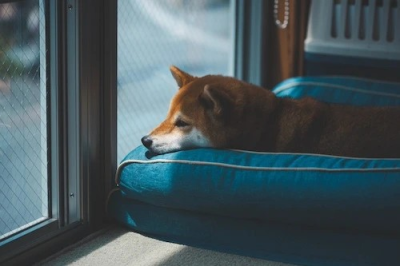Separation anxiety in dogs – What it is and how to deal with it?
Author: Lucie Garabasova
Many dog owners may encounter separation anxiety. It is a psychological condition that affects many dogs and can cause significant discomfort not only to them but also to their owners. It manifests in various ways, including destructive behavior, barking, growling, and sometimes even unimaginable mental states. In this article, we will focus on separation anxiety in dogs – what it is, how to recognize it, why it occurs, and how owners can help their dogs cope with this challenging condition, perhaps even with the help of CBD oil for dogs.
What is separation anxiety?
Let’s understand what separation anxiety is so that we can address it effectively.
Separation anxiety in dogs is a psychological condition that affects some dogs when they are left alone or separated from their owners. This state manifests in various types of behaviors and emotional expressions that can be stressful, and sometimes even dangerous, for both the dog and its owner.
How does separation anxiety manifest?
Typical symptoms of separation anxiety in dogs include:
- Destructive behavior: A dog may begin destroying furniture, doors, windowsills, or other objects when left alone.
- Howling, barking, or growling: Some dogs start to bark intensively, howl, or whine when separated from their owners.
- Other signs of anxiety: Excessive licking, urinating or defecating indoors, loss of interest in games or food.
Causes of separation anxiety
The causes of separation anxiety in dogs vary and may include insufficient socialization during puppyhood, traumatic experiences, changes in family situations, or an overly strong bond between the dog and its owner.
How to treat separation anxiety in dogs
Treating separation anxiety may involve training, changing the way a dog perceives separation from its owner, or, in some cases, pharmacological treatment.
If you are unable to handle the situation with your dog at home, we definitely recommend seeking a specialist.
Ignoring separation anxiety won’t make it go away on its own. In 99% of cases, the intensity increases if left unaddressed. For dogs, separation anxiety can even be life-threatening due to destructive behavior.
How to eliminate separation anxiety in dogs
Patience is key for the owner, as it is often a long process that cannot be resolved in a single day, especially if the dog suffers from severe anxiety. Specific advice and approaches tailored to your dog can be provided by a dog trainer or someone specializing in canine behavior.
How to tackle separation anxiety at home
If you want to help your dog yourself, you can start with simple steps:
- Teach your dog the command “place”: This should be a comfortable spot where your dog feels relaxed and can stay for a while when commanded. Use positive reinforcement to ensure your dog enjoys this command.
- Address early signs of anxiety: If your dog begins whining, stealing shoes, or destroying furniture, use clear commands to discourage this behavior.
- Practice being alone: Start by leaving your home for short periods and gradually increase the duration. You can also “pretend” to leave by dressing to go out but staying home, helping your dog stay calm.
How does CBD help with separation anxiety?
CBD naturally calms dogs and harmonizes processes in their bodies, helping to reduce stress. It interacts with the endocannabinoid system, present in all mammals, which regulates body functions such as temperature, pain, sleep, and anxiety. CBD is natural, effective, and non-psychoactive.
How to administer CBD to dogs with separation anxiety
CBD oils or CBD-infused treats are ideal. Choose the correct concentration based on your dog’s weight:
- For dogs up to 5 kg: 2% CBD oil.
- For dogs between 5 and 15 kg: 5% CBD oil.
- For dogs over 15 kg: 10% CBD oil.
For best results, administer CBD oil directly into your dog’s mouth at least twice daily, ideally one dose about 30 minutes before leaving home.
CBD treats are suitable for dogs of any size. However, it’s important to keep in mind that 1 treat = 1 drop of 5% CBD oil for dogs, so you should adjust the dosage accordingly.
CBD oil has the highest bioavailability when administered directly into the mouth. Therefore, apply it directly into your dog's mouth. Ideally, this should be done at least twice a day (you can schedule one of the doses around the time you leave the house and administer it 30 minutes before your departure).
It is crucial to remember that CBD is a natural substance, and its effects can vary based on the dosage for each individual dog. For some dogs, 2 drops twice a day may suffice, while others may require up to 10 drops per day (check out the video: How to Dose CBD for Dogs?). It’s about experimenting with different dosages, starting gradually, allowing a few days to observe the effects, and adjusting the dosage if the desired result is not achieved. Once the desired effect is observed, you’ve found the ideal dose, and there’s no need to increase it further.
If you’re ever unsure about the dosage, don’t hesitate to reach out to us. Our hemp consultation center is ready to provide you with FREE advice at any time.
What other natural remedies are available for separation anxiety?
Of course, there are options. In addition to other herbs (such as rose and lavender), there are also diffusers designed to have a calming effect on dogs. Some owners also turn to conventional treatments and have medication prescribed for their dog by a veterinarian.
How long does separation anxiety last?
The duration of separation anxiety varies greatly, from a few weeks to several months, depending on the owner’s consistency, the dog’s condition, and the underlying cause of the anxiety.
If you have questions about dosing or other concerns, don’t hesitate to contact us. Our cannabis advisors are always ready to assist you for free.



